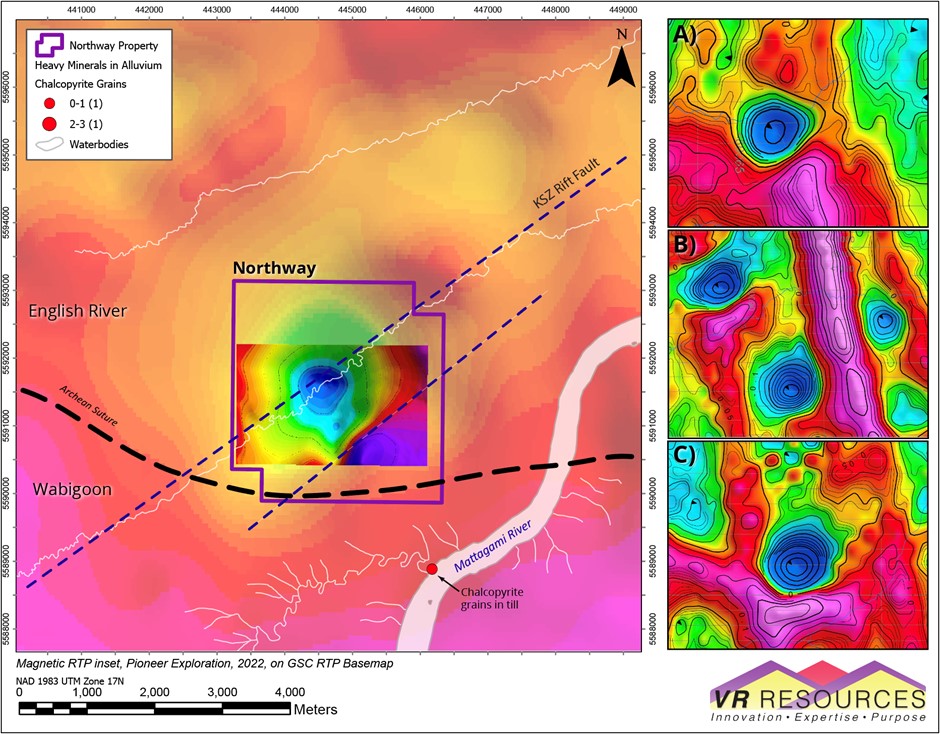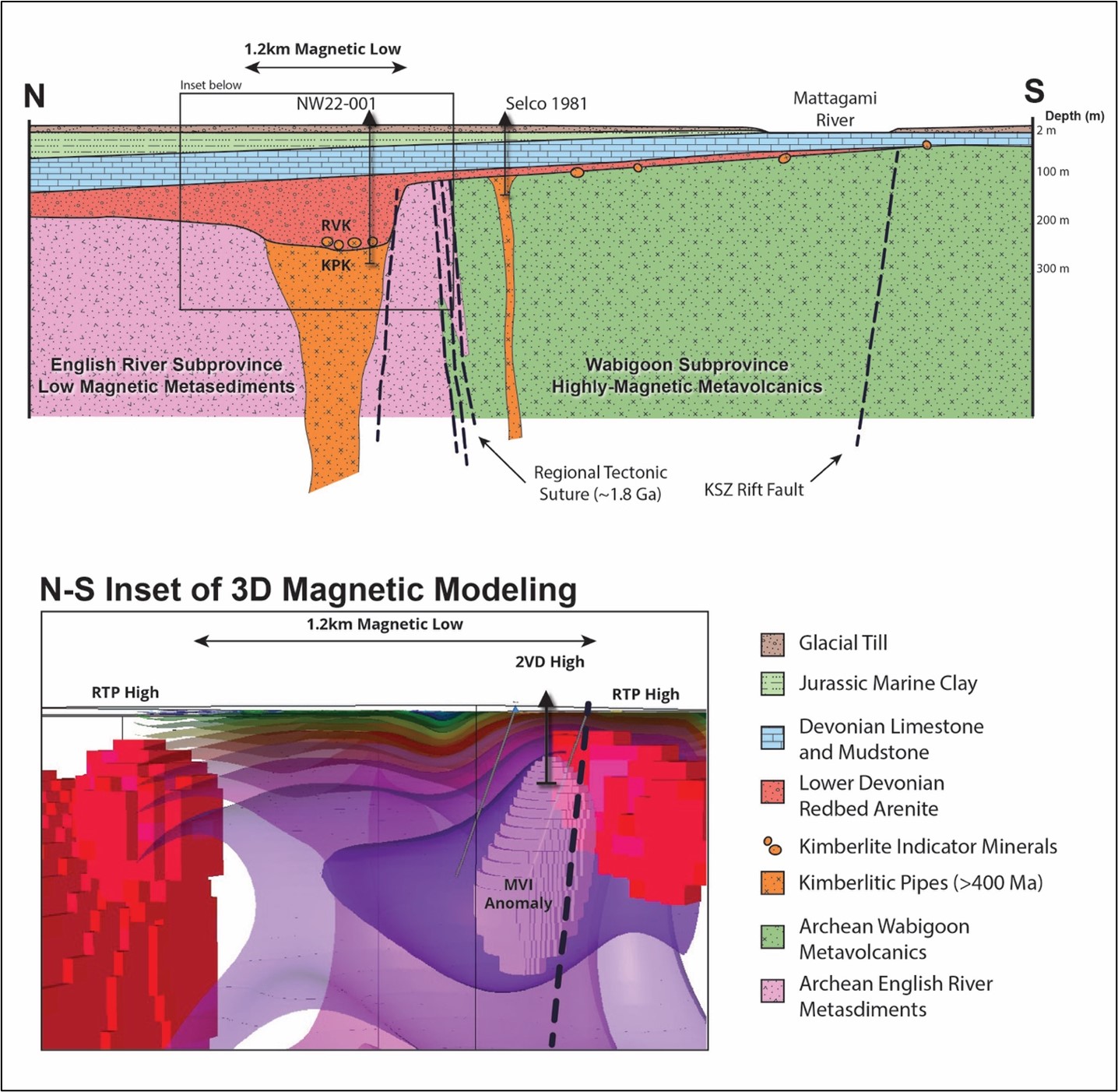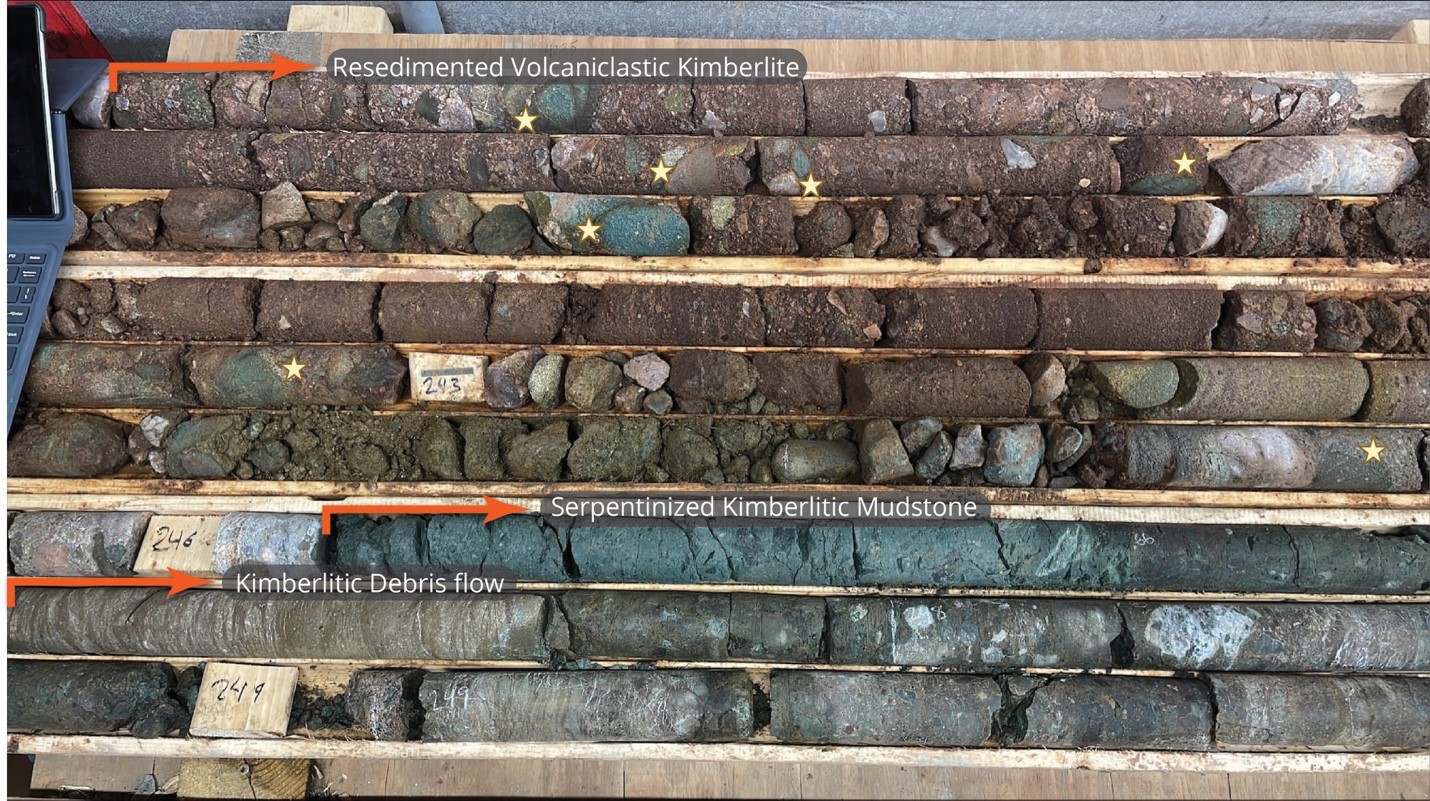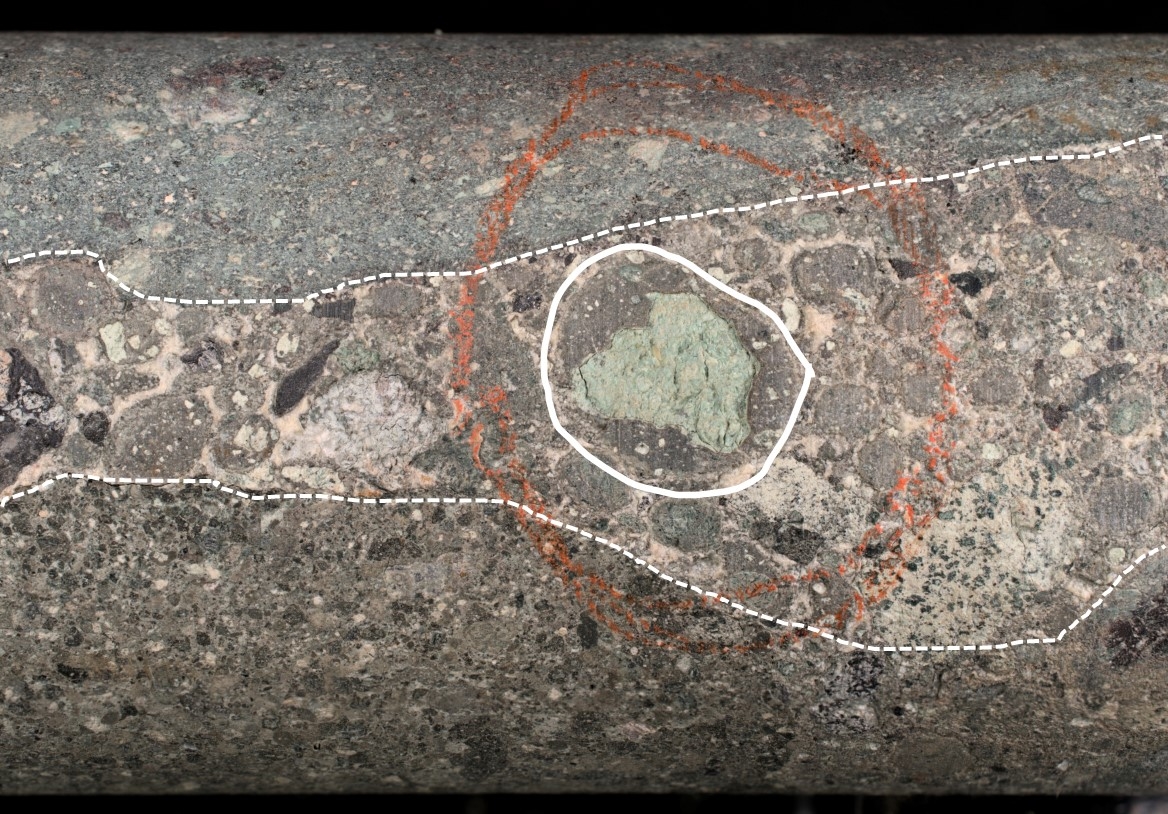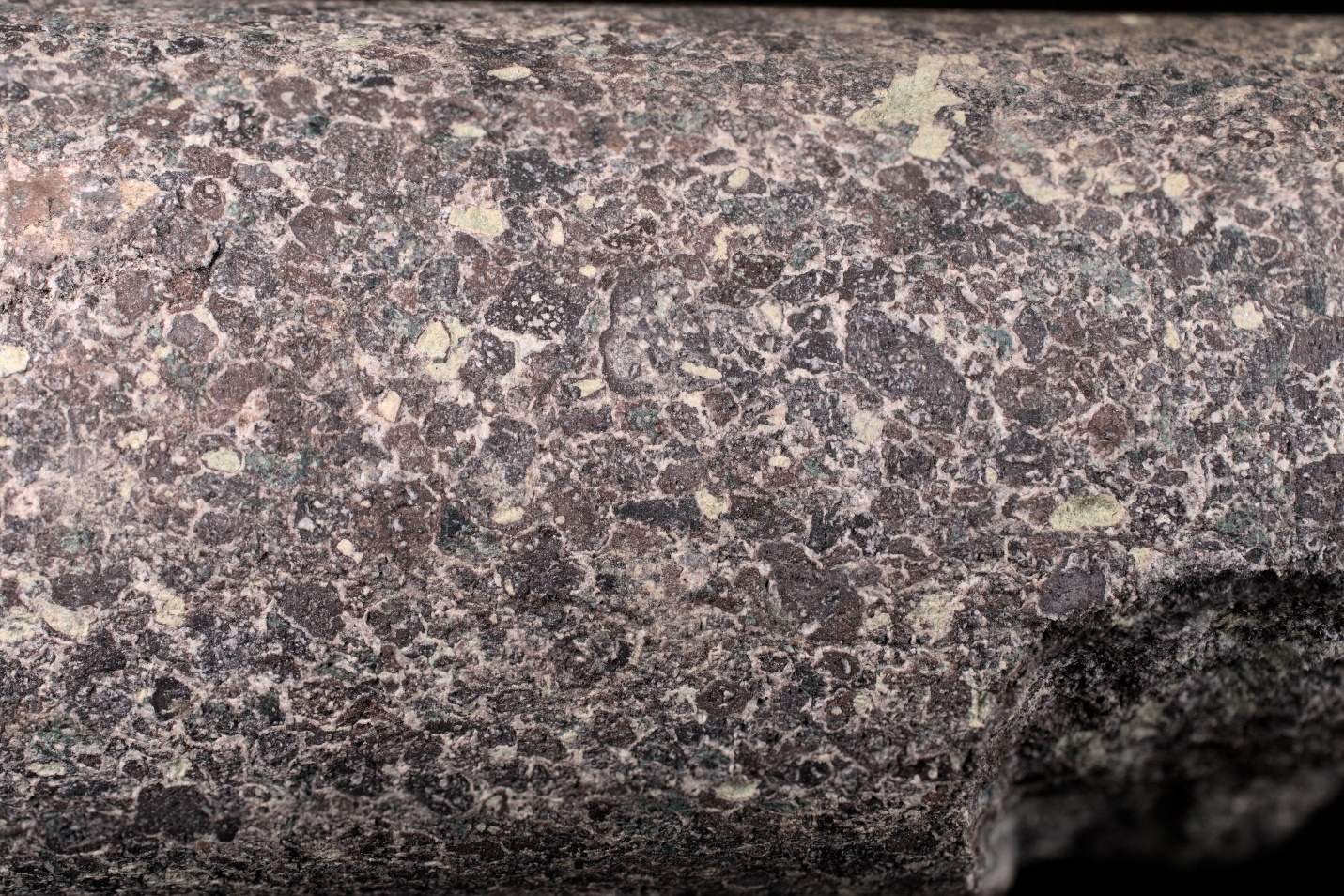VR Discovers a Kimberlite Breccia Pipe at Northway in Northern Ontario

VR Resources Ltd. [TSXV-VRR; FSE-5VR; OTC-VRRCF], the ” Company “, or “VR ”, reports that the diatreme breccia reported last fall at its Northway property located in northern Ontario is a kimberlite breccia pipe.
Highlights
- Drill core relationships suggest mid-Paleozoic age: Northway confirms
the potential for a new kimberlite field in eastern Canada; - VR has staked 20 new Tier 1 and Tier 2 targets;
- VR plans to drill the center of the 1,200 m anomaly at Northway in April.
Description of Drill Hole
Northway was staked directly by the Company in July, 2022, and a single reconnaissance drill hole was completed in November at the end of the fall drill program at Hecla-Kilmer (“H-K”) located 12 km to the southwest (see NR22-17; Nov.15, 2022). As shown on Figure 1 , Northway covers a 1.2 km magnetic anomaly located along the same structural setting as H-K, the Kapuskasing Structural Zone (KSZ).
Drill Hole NW022-001 was completed to 282m. Drilling intersected a diatreme breccia pipe preserved below Paleozoic limestone and sandstone cover, after which the drill program was demobilized, on time and on budget. The Company has now confirmed that the diatreme breccia is a kimberlite pipe.
The drill hole intersected only the weathered, uppermost portion on the eastern edge of the kimberlite pipe at Northway. Despite that, VR has initiated a range of petrology, whole-rock geochemistry and mineral chemistry studies which are ongoing. Drill core photos included in this news release provide a snapshot of the array of textures and important mineralogy observed to-date, including accretionary Kimberley-type pyroclastic kimberlite breccia textures (“KPK”), and garnet-bearing eclogite xenoliths. For a complete assessment of the diamond potential, VR plans to complete and sample a follow-up drill hole down into and across the center of the 1.2km magnetic anomaly at Northway this spring.
Cross Section and Drill Core Photos
Figure 2. The Northway kimberlite is recessive, forming a paleo-topographic depression; Paleozoic sandstone is 100 m thicker over the pipe than it is over basement in nearby drill holes;
Photo 1. The kimberlite pipe is depositionally overlain by Paleozoic-aged Sextant Formation sandstone; the kimberlite pipe is fully preserved. There are “blue rock” cobbles of kimberlite in the lower Sextant, as well as cross-bedded debris flows and a kimberlitic mudstone indicative of subaqueous deposition in a crater facies at the top of the pipe.
Photo 2. Northway is dominated by Kimberley-type, pyroclastic kimberlite diatreme breccia facies (KPK) with magmaclasts and xenoliths including garnet-bearing eclogite.
Photo 3. Northway is a dynamic kimberlite breccia pipe. In just 40 metres of drill core, there is an array of emplacement textures, including KPK breccia with fragments of earlier KPK breccia, and KPK phases injected into previously existing Coherent Kimberlite (CK) phases.
Photo 4. KPK with pyroclasts and magmaclasts with an array of deep crustal xenoliths with accretionary magma rims; many are cored by olivine and some by pyroxene.
Photo 5. Example of an autolith of Coherent Kimberlite (CK) with packed magma globules and broken olivine xenocrysts, hosted within a KPK phase akin to that shown in Photo 4.
CEO Comment on Significance
From VR’s CEO, Dr. Michael Gunning, “As a result of this discovery, VR has staked 20 new Tier 1 and Tier 2 targets in the region ( Figure 1 ). Why? Northway is not simply the discovery of yet another Jurassic kimberlite in eastern Canada because observations in drill core indicate it is mid-Paleozoic in age. As such, the Northway discovery confirms a mid-Paleozoic kimberlite event and potential new kimberlite field in Canada’s northern Superior Craton.
The area west of James Bay was explored extensively for diamonds from the 1960s through 1990s, culminating in the discovery and development by DeBeers of the Victor mine located 300km to the north of Northway. Northway, however, is different from the anomalies targeted during that exploration:
- Northway is a magnetic low, not a magnetic high;
- Northway is large, exceeding 1 km in size, compared to the small magnetic highs typically a few hundred metres across, and;
- Northway is older than the Paleozoic strata (410MA*) which cover it, as opposed to the younger, Mesozoic kimberlite pipes (170MA) targeted previously in the region which come through the Paleozoic limestone to the base of the glacial till cover.
Northway is a direct extension of our work at Hecla-Kilmer using innovative geophysical technologies such as ultra- high resolution drone magnetics to explore large-footprint anomalies on the KSZ, and the kimberlite diatreme breccia pipe discovered in drill hole NW22-001 fits the setting. Further, the independent 3D MVI model shown in Figure 2 refines the target which provides VR with an unusual upside potential for our shareholders that we intend to test this spring.
Based on the array of kimberlitic textures present in just 40 metres of drill core recovered from the absolute top and eastern-most edge of the kimberlite pipe at Northway, the Company is excited to complete an initial drill hole into the center of the associated 1.2 km magnetic anomaly this spring.
Lastly, I want to recognize and thank Kevin Kivi, PGeo, based in Thunder Bay, Ontario, for his contributions to this point, and for joining the VR team as a Technical Advisor. Kevin has been working on the Northway drill core with us since November, and brings a wealth of experience in hands-on diamond exploration, accumulated during the past 30 years, most notably in his roles as both Principal Geologist and Exploration Manager within the North American diamond exploration team at Rio Tinto PLC.”
Technical Information
Summary technical and geological information for the Company’s various exploration properties is available at the Company’s website at www.vrr.ca.
Technical information for this news release has been prepared in accordance with the Canadian regulatory requirements set out in National Instrument 43-101. Justin Daley, P.Geo., VP Exploration and a non-independent Qualified Person oversees all aspects of the Company’s mineral exploration projects, and the content of this news release has been reviewed on behalf of the Company by the CEO, Dr. Michael Gunning, P.Geo., a non-independent Qualified Person.
* MA: million years
About the Northway Property
Northway is approximately 12 km northeast of the Company’s REE critical metal discovery at its Hecla-Kilmer project, itself located 23 km northwest of the Ontario hydro-electric facility at Otter Rapids, the Ontario Northland Railway, and the northern terminus of Highway 634 which links the region to the towns of Cochrane and Kapuskasing to the south, located on the northern Trans-Canada Highway.
The Northway property consists of 47 mineral claims in one contiguous block approximately 3 x 3 km in size and covering 966 hectares. The property is owned 100% by VR. There are no underlying payments or interests on the property and no royalty interests because the property was staked by VR directly.
Northway is located on provincial crown land in northern Ontario, with mineral rights administered by the Ontario Ministry of Northern Development, Mines, Natural Resources and Forestry (“MNDM”). There are no annual payments, but the MNDM requires certain annual exploration expenditures and reporting. The property falls within the traditional territories of the Moose Cree and Taykwa Tagamou First Nations.
About VR Resources
VR is an established junior exploration company focused on unique greenfield opportunities in critical metals, copper and gold (TSX.V: VRR; Frankfurt: 5VR; OTCQB: VRRCF). VR is the continuance of 4 years of active exploration in Nevada by a Vancouver-based private company. The foundation of VR is the diverse experience and proven track record of its Board in early-stage exploration, discovery and M&A. The Company is financed for its exploration strategies and corporate obligations, and focuses on underexplored, large-footprint mineral systems in the western United States and Canada. VR owns its properties outright and evaluates new opportunities on an ongoing basis, by staking or acquisition.
ON BEHALF OF THE BOARD OF DIRECTORS:
“Michael H. Gunning”
____________________________
Dr. Michael H. Gunning, PhD, PGeo
President & CEO
For general information please use the following:
Website: www.vrr.ca
Email: info@vrr.ca
Phone: 778-731-9292
Forward Looking Statements
This press release contains forward-looking statements. Forward-looking statements are typically identified by words such as: believe, expect, anticipate, intend, estimate, postulate and similar expressions or those which, by their nature, refer to future events. Forward-looking statements in this release include those related to the company’s upcoming plans, such as “the Company is excited to complete the initial drill holes into the center of the breccia complex this spring”, and “VR evaluates new opportunities on an ongoing basis.”
This news release contains statements and/or information with respect to mineral properties and/or deposits which are adjacent to and/or potentially similar to the Company’s mineral properties, but which the Company has no interest in nor rights to explore. Readers are cautioned that mineral deposits on similar properties are not necessarily indicative of mineral deposits on the Company’s properties.
Although the Company believes that the use of such statements is reasonable, there can be no assurance that such statements will prove to be accurate, and actual results and future events could differ materially from those anticipated in such statements. The Company cautions investors that any forward-looking statements by the Company are not guarantees of future performance, and that actual results may differ materially from those in forward-looking statements. Trading in the securities of the Company should be considered highly speculative. All of the Company’s public disclosure filings may be accessed via www.sedar.com and readers are urged to review these materials.
Neither the TSX Venture Exchange nor its Regulation Services Provider (as that term is defined in Policies of the TSX Venture Exchange) accepts responsibility for the adequacy or accuracy of this release.
Figure 1. The magnetic anomaly at Northway, as derived from the ultra- high-resolution drone survey completed by VR earlier in 2022, and plotted on the RTP magnetic base map for the region. The faults shown which define and/or disrupt the patterns in the RTP map are parallel to the regional-scale Kapuskasing Shear Zone (KSZ). Also shown is the Archean tectonic suture on the northern boundary of the Wabigoon sub-province of the Superior craton which is shown in cross-section view in Figure 2 . The inset maps on the right show examples of similar magnetic low anomalies in the region that were staked by VR following the kimberlite discovery at Northway, for a total of 20 new properties. Note: the scale bar applies only to Northway.
Figure 2. Schematic North-South cross-section through the magnetic anomaly at Northway, and south to the Mattagami River. It shows the paleo-topographic depression formed above the crater facies at the top of the Northway kimberlite pipe; the Paleozoic sediments which filled the depression are at least 100m thicker than the otherwise thin and uniform stratigraphy of the Devonian sandstone unit elsewhere in the region. The lower inset panel shows the MVI model derived from the ultra- high resolution drone magnetic survey completed at Northway by VR in 2022. The magnetic inversion model maps the kimberlite breccia pipe intersected in drill hole NW22-001, and indicates a steeply west-dipping magnetic contact against metamorphosed wall rock to the east, which is consistent with KSZ regional structures evident on plan maps.
Photo 1. Transition from Sextant Formation red bed arenite of 410 MA age in the top two core boxes into reworked kimberlite pipe in the lower core box. The “ blue rock ” cobbles of eroded kimberlite in the overlying Sextant Formation (highlighted by yellow stars) and the underlying serpentinized kimberlitic mudstone together indicate that the kimberlite breccia pipe was emplaced and weathered prior to 410 million years ago. The crater-fill, re-sedimented volcaniclastic kimberlite (RVK) in the lower two core rows shows bedded, kimberlitic sandstone grading upwards into debris flow with 3-7cm kimberlite autholiths, xenoliths and granitoid wall rock fragments. This sequence represents the kimberlite crater-fill facies which transitions downward into the magmaclast and xenocryst-rich KPK phases of the actual kimberlite pipe itself, as shown in the drill core photos which follow.
Photo 2. Core photo of 3cm wide eclogite xenolith with accretionary crust in tightly packed magmaclast and accretionary pyroclast-rich KPK. Pyroclasts are cored by kimberlite autoliths as well as green chrome-diopside and serpentinized olivine, with xenocrysts of ilmenite, phlogopite and broken olivine found in the KPK matrix. Several lithospheric xenocrysts and xenoliths have been observed in just 40m of core through the kimberlite.
Photo 3. Northway is a dynamic kimberlite breccia pipe with an array of emplacement textures observed in drill core, including xenolith-rich KPK, magmaclast-rich KPK and Coherent Kimberlite (CK). Here, a KPK phase with large irregular olivine xenocryst intrudes up core axis into surrounding medium grained Coherent Kimberlite (CK) units. There are several populations of olivine macrocrysts and xenocrysts throughout the interval.
Photo 4. An example of Kimberley-type, pyroclastic kimberlite diatreme breccia facies (KPK), with packed magmaclasts and pyroclasts , some cored by olivine and/or pyroxene, and with an array of dunite and other mafic, deep crustal xenoliths, commonly with accretionary rims.
Photo 5. Textural variations at Northway include this example of an autolith of Coherent Kimberlite (CK), with packed magma globules and broken olivine xenocrysts in a matrix of late carbonate and serpentine, hosted within a KPK phase akin to that shown in Photo 4.

